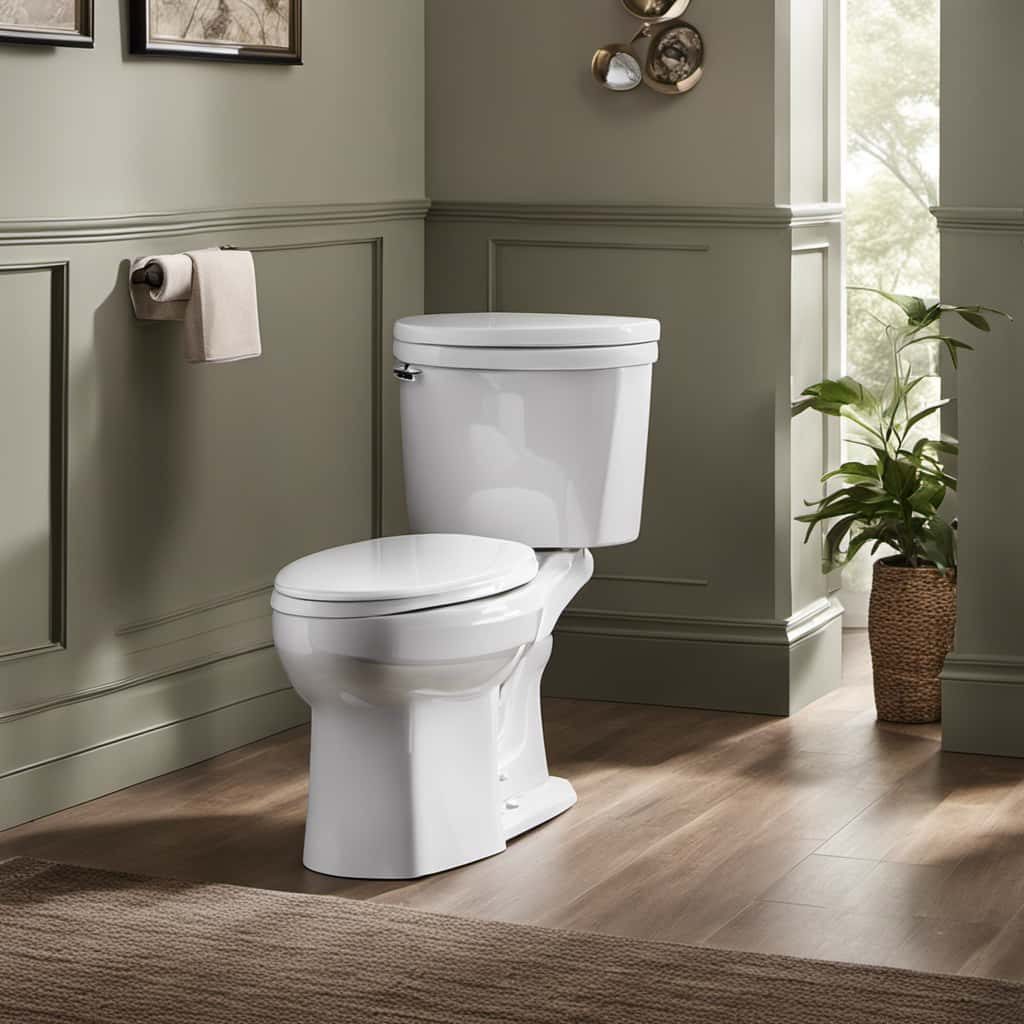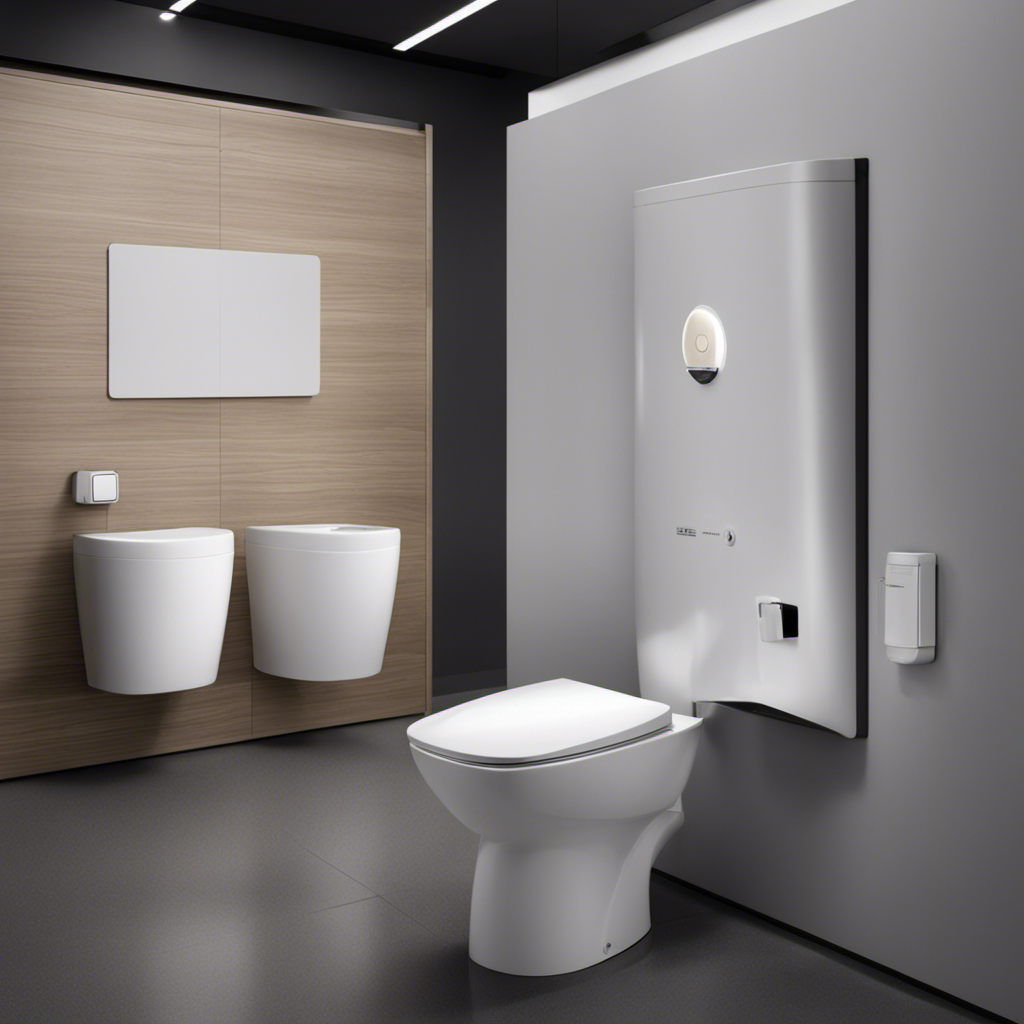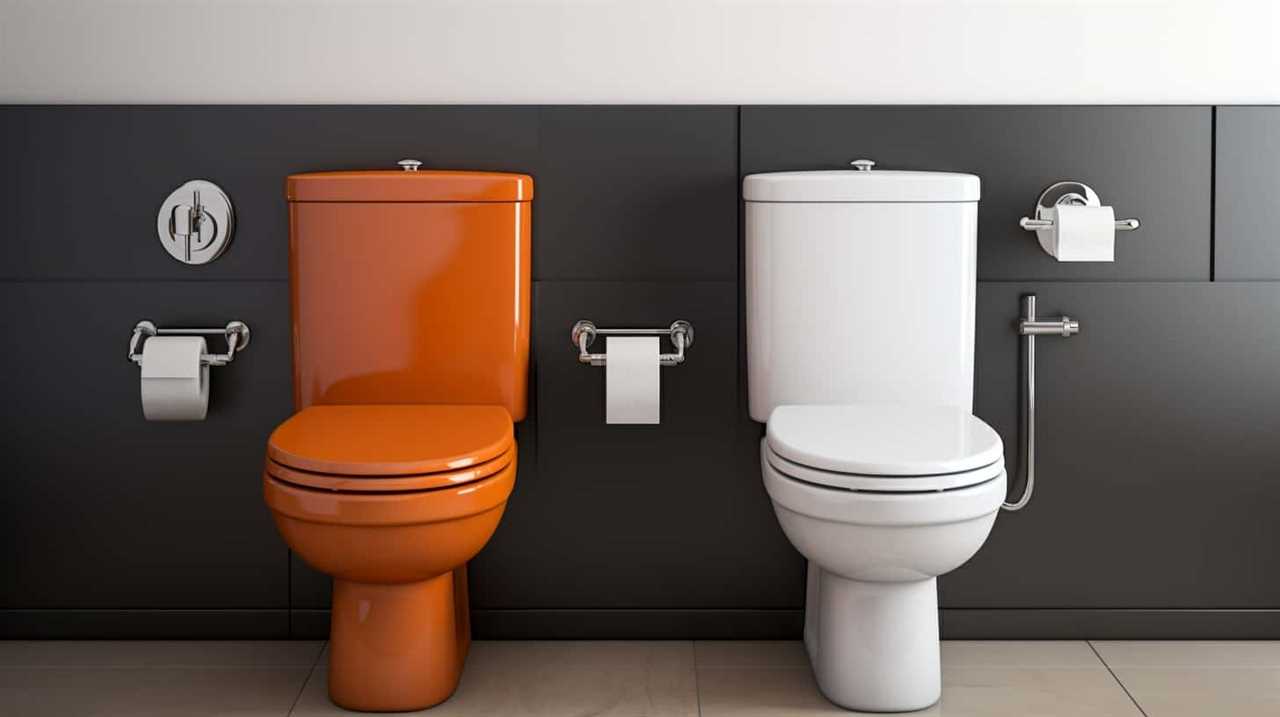Have you ever pondered what enables a toilet to flush effectively? In this article, we’re going to examine the structure of a toilet and investigate the elements that provide it with the capacity to effectively dispose of waste.
From the role of gravity and water to trapway design and flapper valves, we will take a technical and informative approach to help you understand the intricate workings behind a toilet’s flushing power.
Get ready to master the art of toilet mechanics!
Key Takeaways
- Gravity and water pressure are key factors in creating a powerful flushing action.
- Dual flush systems and water-saving technology contribute to efficient flushing mechanisms.
- Innovative flushing technologies, such as dual-flush systems and pressure-assisted toilets, enhance flushing power while conserving water.
- Water volume, trapway design, and siphonic action play important roles in optimizing flushing power.
Anatomy of a Toilet
The anatomy of a toilet consists of various components that work together to create a powerful flushing action. Gravity and water pressure play a critical role in this process.

When the toilet is flushed, gravity pulls the water down from the tank into the bowl. As the water enters the bowl, it creates a strong force that pushes waste down the drain.
The shape of the bowl also contributes to the flushing power. The curved design helps to create a vortex, which enhances the flushing action by increasing the velocity of the water.
Additionally, the trap seal, a small amount of water that remains in the bottom of the bowl, prevents odors and gases from escaping into the bathroom.
Understanding the anatomy of a toilet is essential in understanding how gravity and flushing power work together to create an efficient and effective flushing system.

Gravity and Flushing Power
When it comes to the flushing power of a toilet, two key factors come into play: water pressure and gravity. The force of water pressure helps to create the initial momentum needed to move waste through the pipes, while gravity provides the downward pull that allows waste to be effectively flushed away.
Another important mechanism that contributes to efficient flushing is siphoning, which helps to maintain a continuous flow of water and waste. Understanding these principles can help us design toilets that maximize flushing power and minimize water usage.
Water Pressure and Gravity
We rely on a combination of water pressure and gravity to generate the powerful flushing force that efficiently removes waste from toilets.
In terms of toilet design, water pressure is created by the supply line that brings water into the tank. The water pressure pushes the water through the flushing mechanism and into the bowl.

Additionally, gravity plays a crucial role in the flushing process. When the flushing mechanism is activated, the water is released from the tank and flows down into the bowl due to the force of gravity. This downward flow creates a surge of water that generates the necessary water velocity to effectively flush away waste.
The combination of water pressure and gravity ensures a forceful and efficient flushing action.
Now, let’s move on to the next section to explore the role of siphoning and flushing in the toilet flushing process.
Siphoning and Flushing
To understand the flushing power of a toilet, let’s delve into the role of siphoning and flushing in the process.

When you flush a toilet, water flows from the tank into the toilet bowl. As the water fills the bowl, it creates a siphoning effect, which is crucial for flushing. The water in the bowl forms a seal, preventing air from entering.
When the flush valve opens, the sudden release of water creates a powerful force that pushes waste down the drain. This force is amplified by the siphoning effect, as the water in the bowl continues to flow and pull waste with it.
Understanding how siphoning and flushing work together helps us appreciate the efficiency of modern toilet designs.
Now, let’s explore the role of efficient flushing mechanisms in maximizing flushing power.

Efficient Flushing Mechanisms
One crucial factor in maximizing toilet flushing power is the use of efficient flushing mechanisms, such as gravity. These mechanisms ensure that water is effectively and forcefully pushed down the drain, carrying waste with it.
In addition to gravity, advancements in water saving technology have led to the development of dual flush systems. These systems allow users to choose between a full flush and a partial flush, depending on the amount of waste being disposed of. By reducing the amount of water used for lighter flushes, dual flush systems contribute to both water conservation and efficient flushing.
These mechanisms, combined with proper toilet design and maintenance, play a significant role in achieving optimal flushing power.
As we explore further, we’ll delve into the role of water in flushing and its impact on toilet performance.

The Role of Water in Flushing
Water plays a crucial role in the flushing process, contributing to the overall power and effectiveness of the flush. The pressure and force of the water are key factors in creating a strong flush that efficiently removes waste from the bowl.
Efficient water usage is also important, as too little water can result in incomplete flushing, while excessive water usage can lead to unnecessary waste.
Understanding the importance of water in flushing helps ensure optimal performance and a cleaner toilet.
Water Pressure and Force
When it comes to the power of a toilet flush, the role of water pressure and force can’t be underestimated. Understanding how water pressure and force contribute to a powerful flush is essential for achieving efficient toilet performance. Here are four key factors to consider:

- Water Flow: The amount of water released during a flush directly affects the flushing power. A higher water flow rate means more water is available to create the necessary force to remove waste effectively.
- Water Velocity: The speed at which water exits the tank and enters the bowl is crucial. Higher water velocity helps to carry waste away more efficiently, enhancing the flushing power.
- Pressure-assisted Systems: Some toilets use compressed air or water pressure to enhance the flushing force. These systems provide an extra boost of power, ensuring effective waste removal.
- Gravity: Gravity plays a significant role in the flushing process. The force of gravity helps to pull waste down the drain, aided by the water flow and velocity.
Understanding the importance of water pressure and force in a toilet flush allows for more informed decisions about efficient water usage.
Efficient Water Usage
To achieve efficient toilet performance, it’s important to understand the role of water in flushing by considering the efficient usage of water. Efficient water conservation plays a crucial role in minimizing water wastage while maintaining optimal flushing power.
Innovative flushing technologies have been developed to ensure efficient water usage without compromising performance. These technologies include dual-flush systems that allow users to choose between a lower volume flush for liquid waste and a higher volume flush for solid waste. Additionally, pressure-assisted toilets use compressed air or water to provide a strong flushing force while using less water.
By implementing these efficient water conservation techniques and embracing innovative flushing technologies, we can achieve a balance between water conservation and effective flushing performance.

This understanding of efficient water usage sets the foundation for exploring the importance of water in toilet flushing.
Importance of Water
We rely on a key element to ensure the powerful flush of a toilet: the presence of an ample amount of liquid. Without sufficient water, the flushing mechanism would be ineffective, leading to clogs and inefficient waste removal.
Here are four reasons why water is crucial for an efficient flush:
- Hydraulic pressure: Water acts as a driving force, creating hydraulic pressure that propels waste through the drain pipe.
- Dilution: Adequate water volume dilutes waste, reducing its viscosity and making it easier to flush away.
- Scouring action: The force of water rushing down the bowl helps to scrub and remove residue, preventing buildup and maintaining cleanliness.
- Preventing blockages: Sufficient water flow prevents solid waste from getting stuck in the drain pipe, reducing the chances of clogs and resulting in a more reliable flush.
Understanding the importance of water in flushing reinforces the need for efficient water usage and water conservation, promoting sustainability in our daily lives.

The Importance of Trapway Design
The efficiency of a toilet’s flushing power greatly relies on the design of its trapway. Trapway design innovations have been developed to optimize water flow and ensure effective waste removal. A well-designed trapway should have a smooth, curved shape that allows for efficient water movement and prevents clogs. The diameter and length of the trapway also play a crucial role in determining the flushing power.
A larger diameter allows for a greater volume of water to flow through, while a longer trapway provides more time for the water to build up pressure and create a strong flush. Additionally, trapways with glazed surfaces reduce friction and promote smoother water flow.
Understanding the importance of trapway design sets the stage for exploring the next key component of a toilet’s flushing system: the flapper valve.
Understanding Flapper Valves
Next, let’s delve into the role of flapper valves in enhancing a toilet’s flushing power. Flapper valves are crucial components in the flushing mechanism of a toilet. Here are four key aspects to understand about the function and maintenance of flapper valves:

- Function: Flapper valves control the release of water from the tank into the bowl during a flush. When the toilet handle is pressed, the flapper valve lifts, allowing water to rush into the bowl, creating a powerful siphon action that effectively removes waste.
- Water Conservation: Properly functioning flapper valves ensure that the right amount of water is released for an efficient flush, helping conserve water and reduce utility bills.
- Maintenance: Regular inspection and maintenance of flapper valves are essential to prevent leaks and ensure optimal flushing power. Check for any signs of wear or damage and replace the flapper valve if necessary.
- Adjustment: If your toilet’s flush seems weak, adjusting the chain length connected to the flapper valve can improve flushing power. Ensure that the chain is neither too tight nor too loose for optimal performance.
Understanding the importance of flapper valves and performing regular maintenance can help ensure a powerful and efficient flush every time.
The Significance of Jet Holes
Jet holes play a crucial role in the flushing power of a toilet. These small openings, strategically placed around the rim and sometimes under the rim, release pressurized water into the bowl during a flush.
The force and direction of the water flow from the jet holes help to create an effective flushing action that efficiently removes waste from the bowl.
Jet Hole Function
When considering the flushing power of a toilet, it’s important to understand the significance of the jet hole function. The jet holes play a crucial role in the efficiency of the flushing process, as they’re responsible for directing the water flow and creating the necessary pressure. Here are four key aspects to consider regarding the jet hole function:

- Jet hole position: The placement of the jet holes is strategically designed to ensure maximum coverage of the bowl surface. By positioning the jet holes in specific locations, the water can effectively reach all areas, minimizing the chances of residue accumulation.
- Jet hole size: The size of the jet holes determines the force of the water flow. Larger jet holes allow for a more powerful flush, while smaller ones provide a gentler and controlled flow.
- Water velocity: The jet holes regulate the velocity at which the water is released into the bowl. This velocity is carefully calibrated to create a forceful flush that effectively removes waste without causing splashing or excessive noise.
- Water distribution: The jet holes are designed to distribute the water evenly throughout the bowl. This ensures thorough cleaning and prevents any areas from being missed during the flushing process.
Understanding the significance of the jet hole function is essential in evaluating the flushing power of a toilet. By considering factors such as jet hole position and size, manufacturers can optimize the efficiency of their toilets, providing users with a superior flushing experience.
Flushing Effectiveness
To understand the significance of jet holes in toilet flushing effectiveness, it’s important to consider how they contribute to the overall efficiency of the process.
Jet holes play a crucial role in the flushing mechanisms of toilets, ensuring water efficiency and effective waste removal. These small openings are strategically placed around the rim of the toilet bowl, allowing water to flow out at high pressure and create a powerful flushing action.
The force generated by the water jet helps to dislodge and carry away waste, preventing clogs and ensuring a thorough clean. Additionally, jet holes contribute to water efficiency by optimizing the use of water. By directing the water flow precisely, jet holes maximize the cleaning power while minimizing the amount of water required for each flush.

This combination of powerful flushing and water conservation makes jet holes a vital component in the overall effectiveness of toilet flushing.
Exploring Siphonic Action
We can explore the siphonic action that gives a toilet its flushing power. Siphonic action is a powerful mechanism that utilizes the force of gravity and air pressure differentials to create a strong flush. Here are four key points to consider when examining this phenomenon:
- Benefits of siphonic action:
- High flushing efficiency: Siphonic toilets can effectively remove waste with minimal water usage.
- Stronger flush: The siphonic action creates a forceful pull that clears the bowl quickly and thoroughly.
- Quieter operation: Compared to other flushing mechanisms, siphonic toilets tend to produce less noise during operation.
- Reduced clogging: The powerful flush generated by siphonic action helps minimize the risk of clogs.
- Drawbacks of siphonic action:
- Limited design options: Siphonic toilets require a specific trapway design, limiting the variety of toilet styles available.
- Higher cost: Due to their complex design, siphonic toilets are often more expensive than other flushing mechanisms.
- Potential for splashing: The strong flush of siphonic toilets may result in some water splashing back, requiring careful positioning of the user.
Understanding the benefits and drawbacks of siphonic action allows us to appreciate the engineering behind a toilet’s flushing power.
Tank Size and Flushing Performance
Tank size plays a crucial role in determining a toilet’s flushing power. The larger the tank capacity, the more water it can hold, resulting in a stronger flush.

Additionally, there’s a correlation between tank size and flushing efficiency, as a larger tank can provide a more consistent and powerful flow of water, effectively clearing the bowl with each flush.
Tank Capacity’s Impact
When considering the impact of tank capacity on flushing performance, it’s important to understand how the size of the tank affects the power of the flush. Here are four key points to consider:
- Tank Size: The larger the tank, the more water it can hold, resulting in a stronger flush. This is because a larger volume of water creates more pressure when it’s released.
- Water Consumption: It’s crucial to strike a balance between tank size and water consumption. While a larger tank can provide a powerful flush, it also consumes more water. Efficient toilets are designed to optimize water usage without compromising flushing performance.
- Gravity-Assisted Flushing: Tanks with larger capacities enable gravity-assisted flushing, where a larger volume of water is released, creating a forceful flush that effectively clears the bowl.
- Consistent Performance: With a larger tank capacity, toilets can maintain consistent flushing performance even under heavy usage, ensuring that waste is efficiently removed.
Understanding the impact of tank size on flushing performance is a crucial aspect of evaluating a toilet’s efficiency. Now, let’s explore the correlation between flushing efficiency and tank design.
Flushing Efficiency Correlation
Considering the impact of tank capacity on flushing performance, it’s important to analyze the correlation between tank size and flushing efficiency.
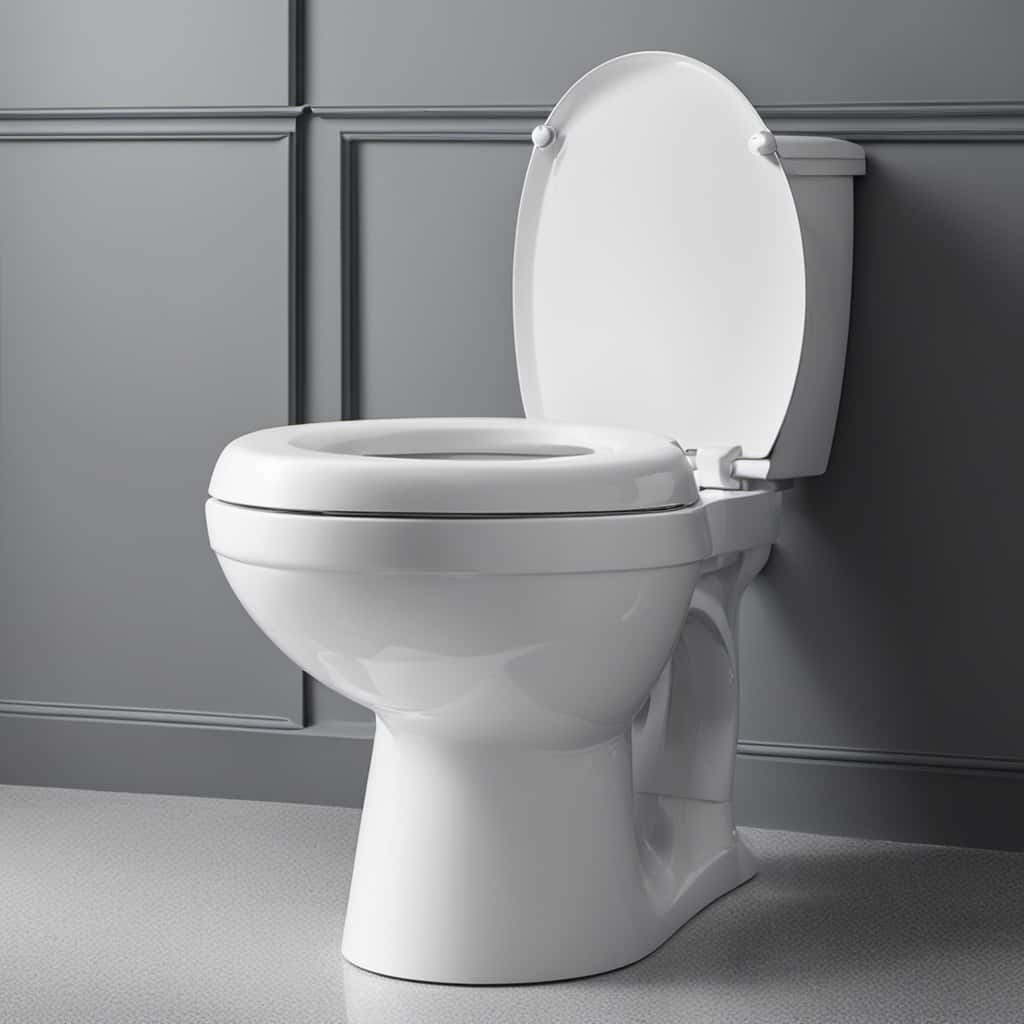
Flushing efficiency refers to the ability of a toilet to effectively remove waste while minimizing water usage. Several factors contribute to flushing efficiency, including the tank size. A larger tank allows for a greater volume of water, resulting in a more forceful flush.
However, it’s crucial to strike a balance between tank size and water usage optimization. A tank that’s too large may lead to excessive water consumption, while a tank that’s too small may not provide enough water for an efficient flush.
Therefore, manufacturers strive to find the optimal tank size that ensures both effective waste removal and water conservation.
The Impact of Water Pressure
To maximize a toilet’s flushing power, we rely on the forceful flow of water propelled by high pressure. The impact of water pressure on flushing efficiency can’t be overstated. Here are four key points to understand the significance of water pressure in toilet flushing:

- Water pressure measurement: Water pressure is measured in pounds per square inch (psi) and determines the strength of the water flow. Higher pressure results in a more powerful flush.
- Impact on water supply: In areas with low water pressure, toilets may not have enough force to clear waste properly. This can lead to clogs and inefficient flushing.
- Efficient water usage: Adequate water pressure ensures that toilets use water efficiently. With the right pressure, toilets can effectively remove waste using less water, contributing to water conservation efforts.
- Maintenance considerations: Proper water pressure is crucial for the longevity and functionality of toilet components. Excessively high pressure can damage internal mechanisms, while low pressure can lead to incomplete flushing.
Understanding the impact of water pressure on toilet flushing is essential for maintaining a functional and efficient bathroom fixture.
The Role of Rim Holes
One key factor in maximizing a toilet’s flushing power is through the effective utilization of the water flow from the rim holes. Rim holes, located under the rim of the toilet bowl, play a crucial role in the flushing process. Their function is to distribute water evenly around the bowl, ensuring that all areas are thoroughly cleaned and waste is efficiently removed.
The effectiveness of rim holes is determined by their size, position, and number. The size of the rim holes affects the volume of water flowing through them, while their position determines the direction of the water flow. Additionally, the number of rim holes impacts the overall coverage and force of the flushing action.
Therefore, optimizing the rim hole function and effectiveness is essential for achieving a powerful and efficient flush.
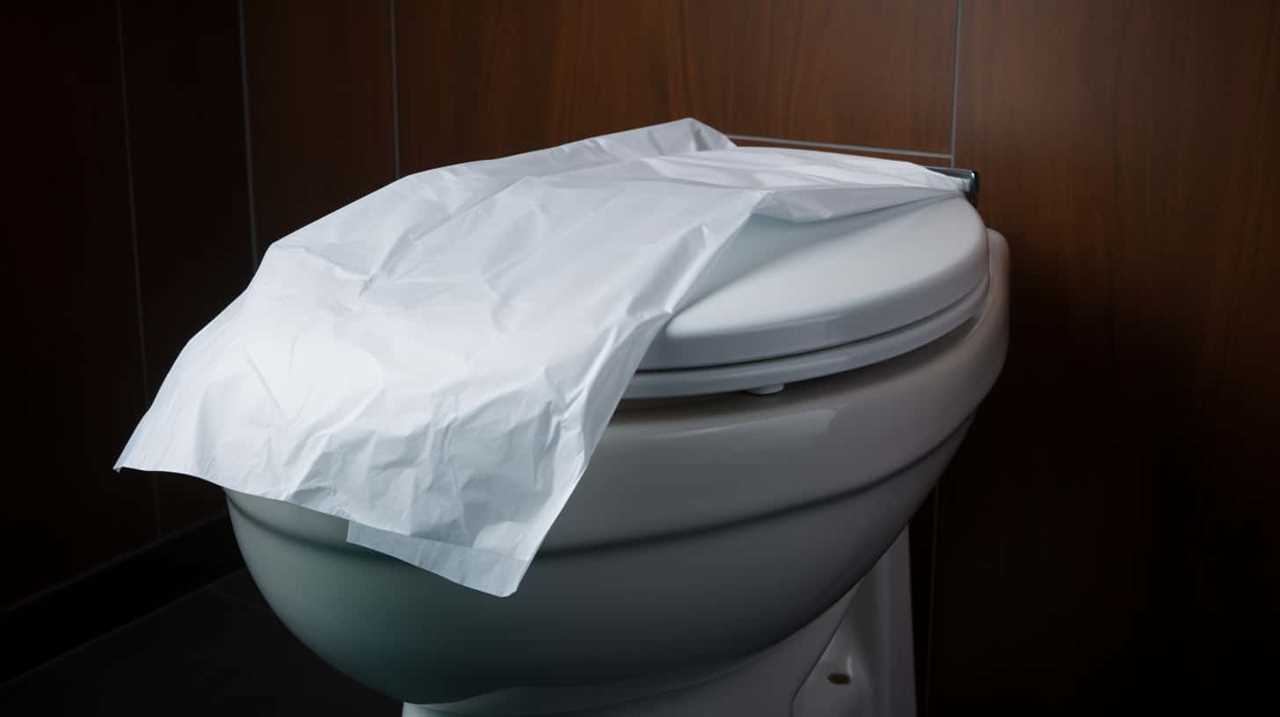
The Influence of Bowl Shape
Now let’s delve into how the shape of the toilet bowl influences its flushing power and continue exploring the importance of rim holes by examining their interaction with the bowl design.
The bowl shape plays a crucial role in maximizing toilet efficiency. Here are four key ways in which bowl design affects flushing power:
- Contour: The curvature of the bowl determines the movement of water during a flush, ensuring effective waste removal.
- Siphon action: A well-designed bowl creates a strong siphon effect, pulling waste down and preventing clogs.
- Water surface area: The size and shape of the water surface impact the amount of air drawn into the bowl, aiding in waste removal.
- Rim wash: The bowl’s shape affects how efficiently water is distributed through the rim holes, enhancing the cleaning and flushing process.
Understanding the influence of bowl shape allows homeowners and plumbers to select toilets that optimize flushing power and maintain toilet efficiency.
Flushing Power and Bowl Siphons
Our research on toilet flushing power has revealed that bowl siphons greatly contribute to the effectiveness of a flush. A bowl siphon is a mechanism within the toilet bowl that uses the force of gravity and water pressure to create a strong suction to remove waste. This suction is crucial for a powerful flush. By optimizing the shape of the bowl, manufacturers can enhance the siphon effect, leading to improved flushing power. Additionally, advancements in bowl shape optimization have allowed for water usage reduction without compromising flushing power. This means that toilets can now be designed to be more environmentally friendly while still maintaining their effectiveness. The table below summarizes the benefits of bowl siphons and bowl shape optimization in terms of flushing power and water usage reduction.
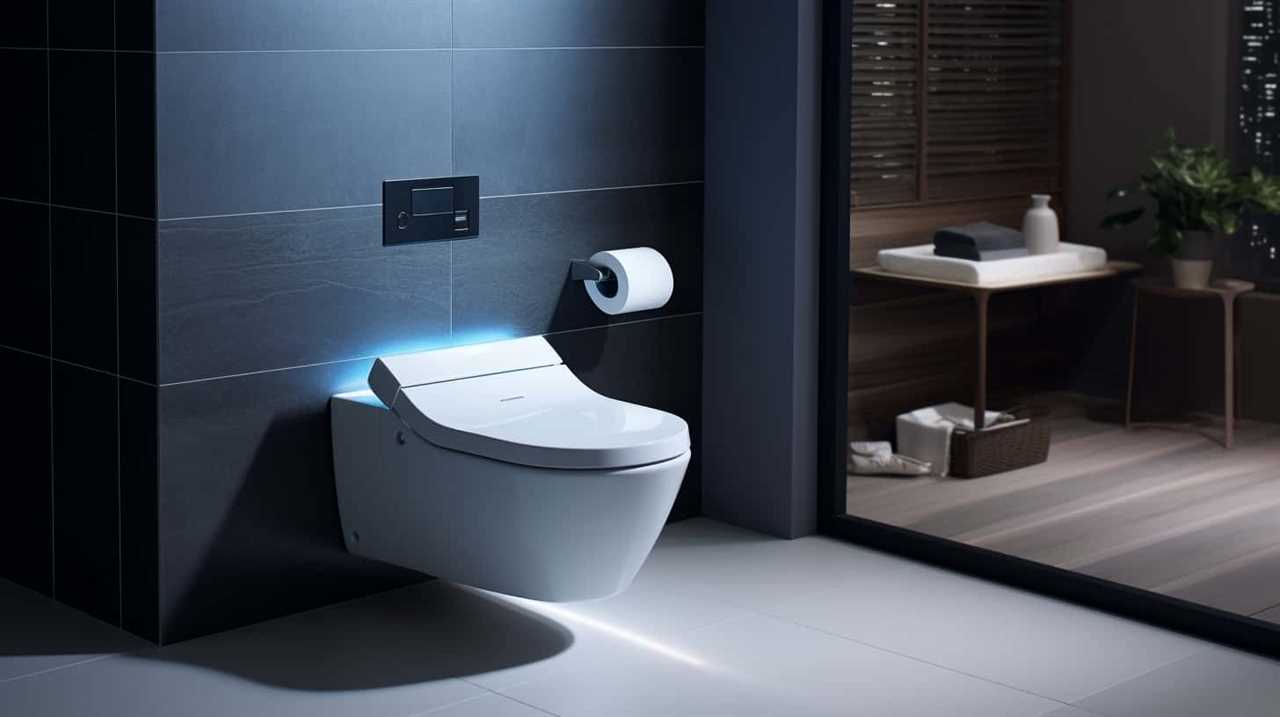
| Benefits of Bowl Siphons | Benefits of Bowl Shape Optimization |
|---|---|
| Strong suction | Improved flushing power |
| Efficient waste removal | Water usage reduction |
The Role of Trap Seal
Trap seal is an essential component that ensures the proper functioning of a toilet’s flushing power. It plays a crucial role in maintaining the water seal that prevents foul odors and harmful gases from entering the bathroom.
To understand the importance of trap seal, consider the following:
- Trapped Water: The trap seal is created by the water that remains in the bottom of the toilet bowl’s trap after each flush.
- Preventing Sewer Gases: The trap seal acts as a barrier, preventing sewer gases from backing up into the bathroom.
- Maintaining Hygiene: A properly maintained trap seal helps maintain a clean and hygienic bathroom environment.
- Troubleshooting: If you notice foul odors or gurgling sounds, it may indicate a problem with the trap seal. Regular trap seal maintenance and troubleshooting can help address these issues promptly.
How Flushometer Toilets Work
Moving on to how flushometer toilets work, let’s delve into their mechanism and functionality.
Flushometer toilets utilize flushometer technology, which is a valve system that controls the flow of water into the toilet bowl. Unlike traditional gravity-fed toilets that rely on a tank of water to create the necessary flushing force, flushometer toilets use a high-pressure water supply directly from the building’s plumbing system.

When the flush handle is pressed, the valve opens, allowing pressurized water to rush into the bowl, creating a powerful flush. This design not only ensures consistent and efficient flushing performance but also contributes to water efficiency.
Frequently Asked Questions
What Are the Different Types of Toilet Flushing Mechanisms?
Toilet flushing mechanisms can be categorized into different types. They include gravity-fed, pressure-assisted, and dual-flush systems. These mechanisms utilize water pressure and siphon action to create the necessary force for an efficient flush.
How Does the Water Level in the Toilet Tank Affect Flushing Power?
The water level in the toilet tank affects flushing power by determining the amount of water pressure that builds up. The higher the water level, the greater the force exerted when the flapper valve is released.
Can the Flushing Power of a Toilet Be Improved by Using Additives in the Tank?
The effectiveness of toilet flushing additives can vary when comparing the impact of different tank additives on toilet flushing power. It is important to consider the specific additives and their potential benefits or drawbacks.
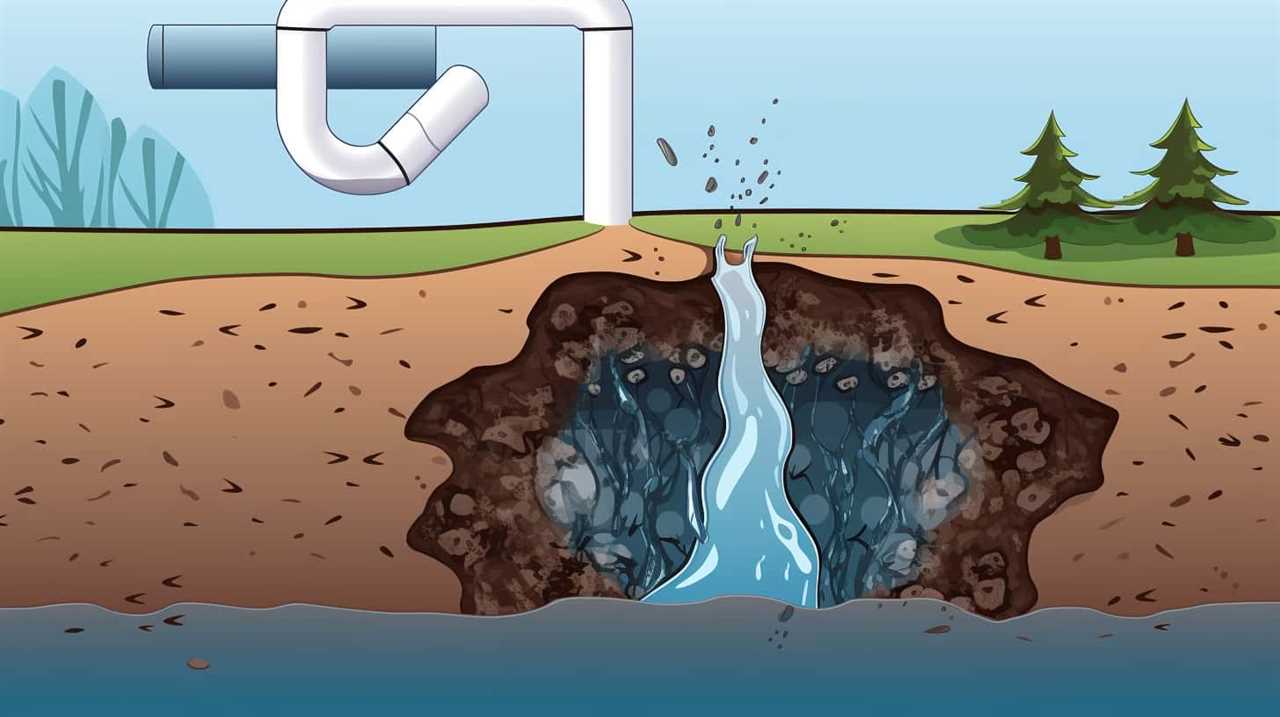
Are There Any Regulations or Standards for Toilet Flushing Power?
Toilet flushing power regulations ensure consistent performance and efficiency. Water pressure plays a crucial role in determining flushing power. Compliance with standards guarantees optimal performance, providing a satisfying flush every time.
What Are Some Common Issues That Can Affect the Flushing Power of a Toilet?
Common issues that can affect the flushing power of a toilet include clogged pipes, low water pressure, and a faulty flapper valve. These problems can reduce the force of the flush and result in inadequate waste removal.
Conclusion
In conclusion, the flushing power of a toilet is determined by various factors such as gravity, water volume, trapway design, flapper valves, and bowl shape.
These elements work together to create a strong siphoning action that effectively removes waste from the bowl.

For example, imagine a family with young children who frequently clog the toilet with excessive toilet paper. A toilet with superior flushing power would ensure that their bathroom experiences are hassle-free and prevent any unpleasant and embarrassing situations.
